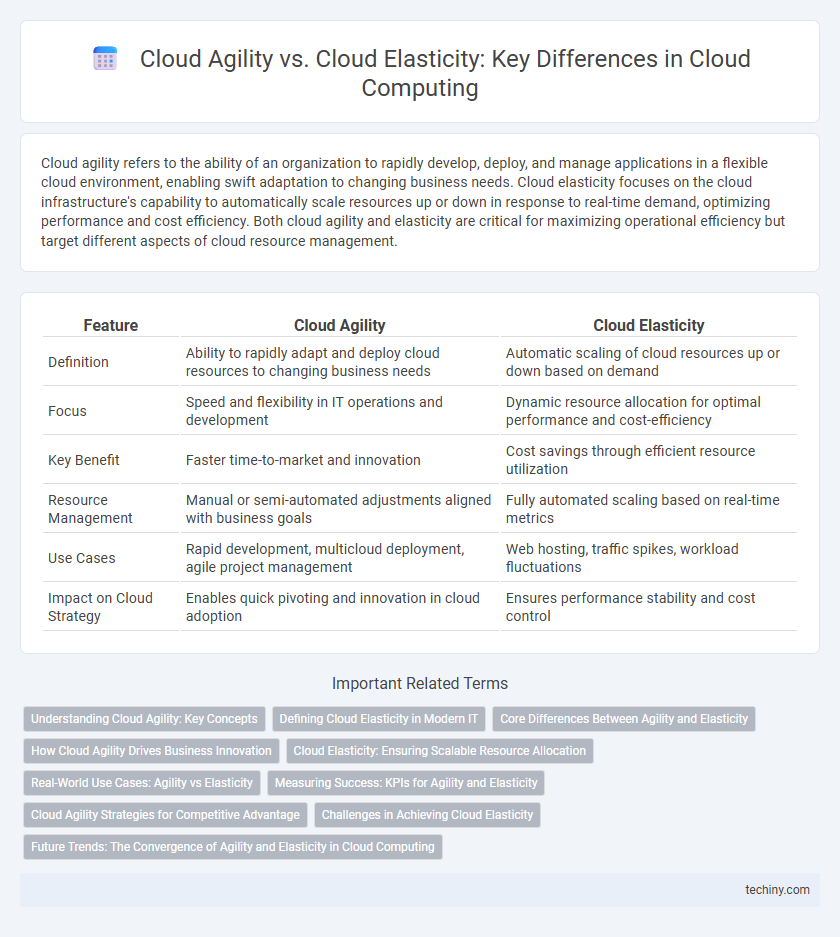Cloud agility refers to the ability of an organization to rapidly develop, deploy, and manage applications in a flexible cloud environment, enabling swift adaptation to changing business needs. Cloud elasticity focuses on the cloud infrastructure's capability to automatically scale resources up or down in response to real-time demand, optimizing performance and cost efficiency. Both cloud agility and elasticity are critical for maximizing operational efficiency but target different aspects of cloud resource management.
Table of Comparison
| Feature | Cloud Agility | Cloud Elasticity |
|---|---|---|
| Definition | Ability to rapidly adapt and deploy cloud resources to changing business needs | Automatic scaling of cloud resources up or down based on demand |
| Focus | Speed and flexibility in IT operations and development | Dynamic resource allocation for optimal performance and cost-efficiency |
| Key Benefit | Faster time-to-market and innovation | Cost savings through efficient resource utilization |
| Resource Management | Manual or semi-automated adjustments aligned with business goals | Fully automated scaling based on real-time metrics |
| Use Cases | Rapid development, multicloud deployment, agile project management | Web hosting, traffic spikes, workload fluctuations |
| Impact on Cloud Strategy | Enables quick pivoting and innovation in cloud adoption | Ensures performance stability and cost control |
Understanding Cloud Agility: Key Concepts
Cloud agility refers to the ability of businesses to rapidly adapt cloud resources and services to meet changing demands, enabling faster innovation and improved responsiveness. Key concepts include scalable infrastructure, automated provisioning, and flexible service models that support dynamic workload management. Emphasizing cloud agility enhances operational efficiency and accelerates time-to-market in competitive digital environments.
Defining Cloud Elasticity in Modern IT
Cloud elasticity in modern IT refers to the capability of cloud infrastructure to automatically scale resources up or down in real-time based on workload demands, ensuring optimal performance and cost-efficiency. This dynamic resource allocation enables businesses to handle varying traffic levels without manual intervention, supporting fluctuating application requirements. Elasticity complements cloud agility by providing the technical flexibility needed for rapid adaptation within cloud environments.
Core Differences Between Agility and Elasticity
Cloud agility emphasizes rapid adaptation to changing business needs by enabling faster deployment, integration, and scaling of applications across multi-cloud environments. Cloud elasticity focuses specifically on automatic scaling of computing resources up or down in real-time based on workload demands, ensuring optimized performance and cost-efficiency. The core difference lies in agility's broader approach to operational flexibility and innovation speed, whereas elasticity targets dynamic resource management for handling variable workloads.
How Cloud Agility Drives Business Innovation
Cloud agility accelerates business innovation by enabling rapid deployment and iterative development of cloud-native applications, allowing organizations to quickly adapt to market changes. This dynamic responsiveness supports continuous integration and delivery pipelines, fostering experimentation and reducing time-to-market. In contrast to elasticity, which focuses on resource scaling, agility empowers businesses to pivot strategies and implement new features seamlessly, driving competitive advantage.
Cloud Elasticity: Ensuring Scalable Resource Allocation
Cloud elasticity enables dynamic scaling of computing resources based on real-time demand, ensuring optimal performance and cost-efficiency in cloud environments. This capability allows automatic adjustment of CPU, memory, and storage resources to handle workload fluctuations without service interruption. Effective cloud elasticity maximizes resource utilization while minimizing overprovisioning and operational expenses.
Real-World Use Cases: Agility vs Elasticity
Cloud agility enables rapid deployment and continuous improvement in development environments, allowing businesses to quickly adapt to changing market demands, as exemplified by fintech companies launching new features in days rather than months. Cloud elasticity supports dynamic resource scaling in real-time, crucial for e-commerce platforms handling fluctuating traffic during events like Black Friday sales, ensuring optimal performance without overprovisioning costs. Organizations leveraging agility for innovation cycles and elasticity for operational efficiency achieve competitive advantages in cloud computing landscapes.
Measuring Success: KPIs for Agility and Elasticity
Key performance indicators (KPIs) for cloud agility include deployment speed, time-to-market, and change failure rate, reflecting an organization's ability to rapidly adapt and deliver new features. Cloud elasticity KPIs focus on resource utilization, cost efficiency, and scaling latency, measuring how effectively infrastructure adjusts to workload demands. Monitoring these metrics enables businesses to optimize their cloud environment, ensuring both flexibility in operations and efficient resource management.
Cloud Agility Strategies for Competitive Advantage
Cloud agility involves rapidly adapting IT resources and processes to changing business needs, enabling organizations to accelerate innovation and respond swiftly to market dynamics. Implementing cloud agility strategies such as continuous integration/continuous deployment (CI/CD), automated scaling, and multi-cloud management enhances operational efficiency and reduces time-to-market. This strategic flexibility drives competitive advantage by empowering businesses to pivot quickly, optimize costs, and deliver superior customer experiences.
Challenges in Achieving Cloud Elasticity
Achieving cloud elasticity involves challenges such as managing unpredictable workloads, ensuring seamless auto-scaling without performance degradation, and optimizing resource allocation to avoid overprovisioning or underutilization. The complexity of real-time monitoring and orchestration tools is critical to dynamically adjust infrastructure while maintaining cost efficiency. Additionally, integrating legacy systems with cloud-native elastic services often complicates elasticity implementation and affects overall system responsiveness.
Future Trends: The Convergence of Agility and Elasticity in Cloud Computing
Cloud agility and cloud elasticity are increasingly converging to drive the next wave of innovation in cloud computing, enabling businesses to rapidly adapt to market changes while efficiently scaling resources. Future trends emphasize integrated platforms that combine automated lifecycle management with real-time resource scaling, enhancing operational flexibility and cost optimization. AI-powered orchestration and predictive analytics will further blur the lines between agility and elasticity, delivering seamless and intelligent cloud environments.
Cloud Agility vs Cloud Elasticity Infographic

 techiny.com
techiny.com